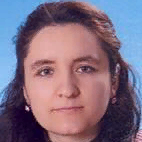
Gokcen Cetinel
Work place: Sakarya University/Electrical and Electronics Engineering Dept., Sakarya, 54187, Turkey
E-mail: gcetinel@sakarya.edu.tr
Website:
Research Interests: Engineering, Computational Engineering, Computational Science and Engineering
Biography
Gökçen Çetinel -was born in TURKEY. She received her M.Sc. from Electronics Engineering, Erciyes University, Turkey in 2004 and Ph. D degree from Electrical and electronics Engineering, Sakarya University, Turkey in 2010. Her research interests include adaptive filters, chaos and their applications to digital communication systems. She is currently working as an Asst. Prof. Dr. at the Electrical Engineering and Electronics Department, Sakarya University, Turkey.
Author Articles
Breast Lesion Segmentation and Area Calculation for MR Images
DOI: https://doi.org/10.5815/ijigsp.2018.10.01, Pub. Date: 8 Oct. 2018
In this paper, our goal is to determine the boundaries of lesion and then calculate the area of existing lesion in breast magnetic resonance (MR) images to provide a useful information to the radiologists. For this purpose, at first stage region growing (RG) method and active contour model (Snake) is applied to the images to make the boundaries of lesion visible.
RG method is one of the simplest approaches for image segmentation and provides accurate results with lower computation time due to its seed point initialization step. Snake method molds a closed contour to the boundary of a region in an image and is also popular in medical image segmentation studies. In the presented study, both of these methods are utilized to determine the lesion boundaries.
After determining the boundaries of lesion accurately in the second stage of the study, bit-quad method is applied to the segmented images. Bit quad method is used to compute the area and perimeter of binary lesion images based on matching the logical state of regions of image to binary patterns. Finally, to evaluate the performance of the proposed study, computer simulations are performed. It is demonstrated via computer simulations that the lesion area and parameter values are very close to real values. By means of this study it is aimed to support radiologists during diagnosis and assessment of breast lesions.
Automated Pre-Seizure Detection for Epileptic Patients Using Machine Learning Methods
By Sevda GUl Muhammed K. UCAR Gokcen Cetinel Erhan BERGIL Mehmet R. BOZKURT
DOI: https://doi.org/10.5815/ijigsp.2017.07.01, Pub. Date: 8 Jul. 2017
Epilepsy is a neurological disorder resulting from unusual electrochemical discharge of nerve cells in the brain, and EEG (Electroencephalography) signals are commonly used today to diagnose the disorder that occurs in these signals. In this study, it was aimed to use EEG signals to automatically detect pre-epileptic seizure with machine learning techniques. EEG data from two epileptic patients were used in the study. EEG data is passed through the preprocessing stage and then subjected to feature extraction in time and frequency domain. In the feature extraction step 26 features are obtain to determine the seizure time. When the feature vector is analyzed, it is observed that the characteristics of the pre-seizure and non-seizure period are unevenly distributed. A systematic sampling method has been applied for this imbalance. For the balanced data, two test sets with and without Eta correlation are established. Finally, the classification process is performed using the k-Nearest Neighbor classification method. The obtained data are evaluated in terms of Eta-correlated and uncorrelated accuracy, error rate, precision, sensitivity and F-criterion for each channel.
[...] Read more.Robust Chaotic Digital Image Watermarking Scheme based on RDWT and SVD
By Gokcen Cetinel LLukman Cerkezi
DOI: https://doi.org/10.5815/ijigsp.2016.08.08, Pub. Date: 8 Aug. 2016
In recent years chaos has received a great deal of attention from the researches specialized in communications, signal and image processing. The complexity property of the chaotic signal raised the idea of using such signals in secure communications. Digital image watermarking is a technique mainly developed for copyright protection and image authentication and it can be considered as one application area of the secure communication. In this study, a chaos based digital image watermarking algorithm based on redundant discrete wavelet transform (RDWT) and singular value decomposition (SVD) is proposed. To the best of our knowledge, there do not exist any digital watermarking scheme combining RDWT, SVD and chaos. Robustness and invisibility of the proposed method are improved by using the logistic mapping function to generate a chaotic image matrix serving as the watermark that is used to modify the singular values of the low frequency sub-band of the cover image obtained by applying RDWT. The method is shown to be robust against both the geometrical and image processing attacks and to provide better watermark concealment via computer simulations. Using a chaotic signal as the watermark allows the proposed scheme to meet the security requirements as well.
[...] Read more.Other Articles
Subscribe to receive issue release notifications and newsletters from MECS Press journals